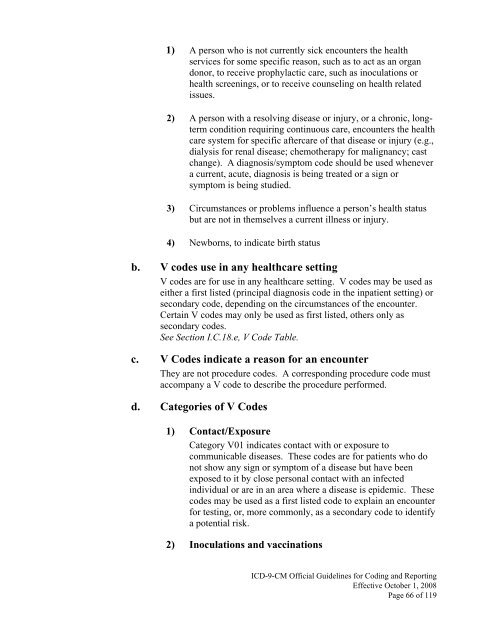ICD-9-CM Official Guidelines for Coding and Reporting - Office of ...
ICD-9-CM Official Guidelines for Coding and Reporting - Office of ...
ICD-9-CM Official Guidelines for Coding and Reporting - Office of ...
You also want an ePaper? Increase the reach of your titles
YUMPU automatically turns print PDFs into web optimized ePapers that Google loves.
1) A person who is not currently sick encounters the health<br />
services <strong>for</strong> some specific reason, such as to act as an organ<br />
donor, to receive prophylactic care, such as inoculations or<br />
health screenings, or to receive counseling on health related<br />
issues.<br />
2) A person with a resolving disease or injury, or a chronic, longterm<br />
condition requiring continuous care, encounters the health<br />
care system <strong>for</strong> specific aftercare <strong>of</strong> that disease or injury (e.g.,<br />
dialysis <strong>for</strong> renal disease; chemotherapy <strong>for</strong> malignancy; cast<br />
change). A diagnosis/symptom code should be used whenever<br />
a current, acute, diagnosis is being treated or a sign or<br />
symptom is being studied.<br />
3) Circumstances or problems influence a person’s health status<br />
but are not in themselves a current illness or injury.<br />
4) Newborns, to indicate birth status<br />
b. V codes use in any healthcare setting<br />
V codes are <strong>for</strong> use in any healthcare setting. V codes may be used as<br />
either a first listed (principal diagnosis code in the inpatient setting) or<br />
secondary code, depending on the circumstances <strong>of</strong> the encounter.<br />
Certain V codes may only be used as first listed, others only as<br />
secondary codes.<br />
See Section I.C.18.e, V Code Table.<br />
c. V Codes indicate a reason <strong>for</strong> an encounter<br />
They are not procedure codes. A corresponding procedure code must<br />
accompany a V code to describe the procedure per<strong>for</strong>med.<br />
d. Categories <strong>of</strong> V Codes<br />
1) Contact/Exposure<br />
Category V01 indicates contact with or exposure to<br />
communicable diseases. These codes are <strong>for</strong> patients who do<br />
not show any sign or symptom <strong>of</strong> a disease but have been<br />
exposed to it by close personal contact with an infected<br />
individual or are in an area where a disease is epidemic. These<br />
codes may be used as a first listed code to explain an encounter<br />
<strong>for</strong> testing, or, more commonly, as a secondary code to identify<br />
a potential risk.<br />
2) Inoculations <strong>and</strong> vaccinations<br />
<strong>ICD</strong>-9-<strong>CM</strong> <strong>Official</strong> <strong>Guidelines</strong> <strong>for</strong> <strong>Coding</strong> <strong>and</strong> <strong>Reporting</strong><br />
Effective October 1, 2008<br />
Page 66 <strong>of</strong> 119
















